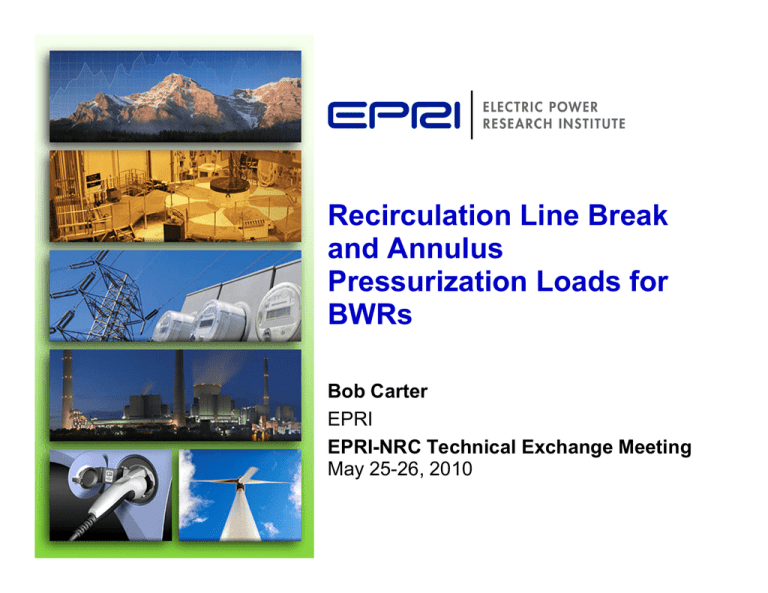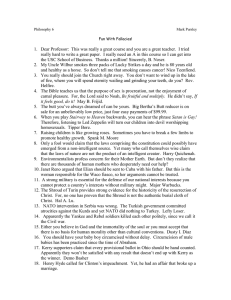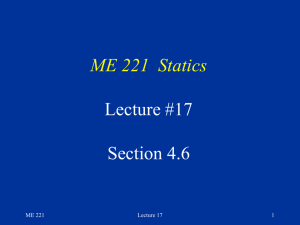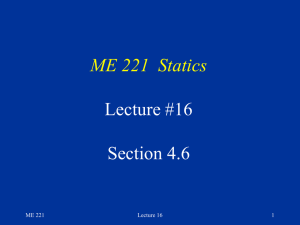
Recirculation Line Break
and Annulus
Pressurization Loads for
BWRs
Bob Carter
EPRI
EPRI-NRC Technical Exchange Meeting
May 25-26, 2010
Background
SC 09-01
• On 6/8/09, GE-Hitachi (GEH) issued Safety Communication (SC) 0901, “Annulus Pressurization Loads”
– A postulated circumferential pipe break, at the piping/RPV nozzle
safe-end interface weld, in any NSSS piping that penetrates the
biological shield wall will discharge mass and energy into both the
annular cavity between the RPV and the biological shield wall
(BSW) and into the drywell
• Asymmetric ΔP within annular region
• Jet Impingement (fluid striking the RPV and BSW)
• Jet Reaction (reactor blow down load)
• Pipe Whip Restraint loads (load caused by the severed pipe
whipping into the pipe whip restraint)
– AP load applies to the RPV and internals, and attached piping and
containment structure/steel with attachments to RPV and BSW
© 2010 Electric Power Research Institute, Inc. All rights reserved.
2
Background
SC 09-01 (cont.)
• The AP dynamic load was included as part of the NSSS
“New Loads Evaluation” that applied to plants licensed in
the late 70’s and 1980’s. This program included new
containment hydrodynamic loads such as chugging
condensation oscillation and SRV discharge loads and AP
loads
– Evaluated the existing NSSS equipment for the original
design loads plus the “New Loads”
– Applied to two Mark I plants (reduced scope at 3
plants), and all Mark II and later containment designs
– The regulatory accepted AP loads methodology
assumed that the maximum mass/energy release
would maximize the structural response and stresses
on the RPV, internals, and containment structures
© 2010 Electric Power Research Institute, Inc. All rights reserved.
3
Background
SC 09-01 (cont.)
– Design based solely on maximum mass and energy release
rate may not determine peak structural response
• Assumptions used for defining input thermal/hydraulic
loads did not consider effect on dynamic structural
response
• Other postulated break locations or power/flow map
operating conditions originally dispositioned as not
limiting could result in higher loads on reactor internals
and attached piping and containment structure/steel
• GEH/BWROG taking lead to resolve
– BWRVIP working closely with BWROG to understand any
impacts of this issue on structural evaluations of internals
© 2010 Electric Power Research Institute, Inc. All rights reserved.
4
GEH Assessment
• SC 09-01
– GEH completed a 10CFR21 evaluation
– Sufficient conservatism in the current structural analysis
methodology and in the individual component stress margins to
accommodate the estimated impact of the increase in the AP load
cases for the two sample plants analyzed
– Does not create a substantial safety hazard or lead to the violation
of any Technical Specification Safety Limits
– GEH has performed sensitivity studies and also taken advantage
of leveraged information from current projects with plants. GEH
has not identified deficiencies in any hardware to date
– Additional efforts continuing to resolve technical issues
© 2010 Electric Power Research Institute, Inc. All rights reserved.
5
Background
SC 09-03
• On 8/3/09, GEH issued Safety Communication (SC) 09-03, “Shroud
Screening Criteria Reports”
– Core shroud screening criteria reports provide allowable flaw
lengths for the shroud circumferential welds
• Reports may have been used by utilities to accept existing
shroud weld flaws and determine inspection frequencies
– Some screening criteria reports may contain some nonconservative recirculation line break (RLB) loads; (Acoustic (AC),
Annulus Pressurization (AP) and/or Flow-Induced (FI))
• AC Load: Very short duration (~ 20 ms) load that acts over the
finite length of time it takes for the shock wave from the break
to travel from the broken recirculation line to the other side of
the annulus
• AP Load: Short duration (~ 500 ms) starts to build during AC
load period
© 2010 Electric Power Research Institute, Inc. All rights reserved.
6
Background
SC 09-03 (cont.)
• FI Load: Quasi-Steady state load is a pressure gradient
load caused by fluid acceleration escaping through the
break
– Follows AC load but overlaps the AP load; shroud
sees impact starting at ~ 500 ms and is fully
p at ~ 1.0 sec
developed
– The allowable flaw lengths for the shroud welds provided in
the shroud screening criteria reports or plant-specific core
shroud flaw evaluations might be affected
• BWRVIP taking lead to resolve
© 2010 Electric Power Research Institute, Inc. All rights reserved.
7
GEH Assessment
• SC 09-03
– GEH completed a 10CFR21 evaluation
– Does not create a substantial safety hazard even if
RLBs loads were not included in the core shroud flaw
evaluations
– Plants with GEH installed tie rod repairs are not
affected since the RLB load combinations include
AC + SSE
– Although not a plant safety or functional concern; AC,
AP and FI loads may affect core shroud flaw
evaluations for plants that have not installed GEH
shroud repairs
© 2010 Electric Power Research Institute, Inc. All rights reserved.
8
Core Shroud Evaluations
• In the 1994-1995 period, a safety assessment of the core shroud was
funded by the BWRVIP
– The BWRVIP contracted GE to perform calculations to assess
shroud integrity and included AC and FI loads calculated using
GE’s TRACG (original WHAM for acoustic & potential flow model
for flow-induced load concluded to be non-conservative by NRC
and GE)
– Demonstrated that the shroud integrity is not compromised for
significant cracks, up to 90% of wall thickness, such that shroud
separation is very unlikely
• NUREG-1544 states “In consideration of the consequences of a 360
degree thru-wall failure of the shroud coincident with a LOCA, the
NRC has conservatively estimated the risk contribution from shroud
cracking and determined that it does not pose a high degree of risk at
this time.”
• BWRVIP concluded there was no immediate safety or operability
concern
© 2010 Electric Power Research Institute, Inc. All rights reserved.
9
Core Shroud Evaluations (cont.)
• AC, AP and FI loads were typically combined separately
with seismic loads using SRSS method, i.e., AC + SSE
and AP + SSE (typically AC bounds FI load)
– AC load is applied directly to the shroud. It affects all
of the shroud welds, but the affects are greater on the
H5 thru H7 welds due to tipping (bending) moment
generated during event.
– AP load is applied to the biological shield wall and the
RPV and is of different duration and magnitude
compared to the AC load.
© 2010 Electric Power Research Institute, Inc. All rights reserved.
10
Core Shroud Evaluations (cont.)
• There is a potential that some inspection frequencies might be
impacted by inclusion of AC and/or AP loads but the number of
affected plants is thought to be few. Reasons are:
– Plants with minimal cracking (<10%) are not expected to be
impacted due to large flaw tolerance
– “Corrective/Preventative Actions” section of SC09-03 states that
plants
l t having
h i GEH shroud
h d repairs
i iinstalled
t ll d are nott iimpacted
t d
– At least one utility is actively reviewing flaw evaluations for their
plants. To date, their re-evaluation has shown that inspection
frequencies are not impacted
– GEH found in three sample (not considered bounding or typical)
cases that the allowable flaw length changed by less than 4%.
The sample cases were evaluated using the original NSSS AP
loads and may change depending on the outcome of the BWROG
SC 09-01 work.
© 2010 Electric Power Research Institute, Inc. All rights reserved.
11
Current GEH/BWROG Actions on SC09-01
• GEH/BWROG Project Plan
– Develop generic basis for plant operability
• Realistic analyses to identify margin inherent in
original design basis analyses
• Leverage recent EPU, MELLLA, MELLLA+ analysis
results
– Scope expanded to address SC 09-01 issues
• Summarize conservatisms in current
structure/component evaluations
– Determine process for future analyses (EPU, MELLLA)
• Address SC 09-01 issues
• Maintain sufficient conservatism overall
© 2010 Electric Power Research Institute, Inc. All rights reserved.
12
Current Actions on SC09-03
• BWRVIP-76, Core Shroud I&E Guideline has been clarified to state
that all postulated design loads, including RLB loads should be
considered if part of the design basis of the plant
• BWRVIP has issued a survey to BWR owners to determine the
number of plants that are indeterminate regarding impact of AC and
AP loads for flaw evaluations
– NRC has reviewed and provided comments on survey
– Will be used to assess the extent of the problem and determine if
any generic actions by the BWRVIP are warranted or whether the
issue is better left to be resolved by the individual plants
• GEH plans to issue a revision to SC 09-03 for clarification and
addition of historical and quantitative information
– Including load definitions
– Including recommended load combinations
– Discussion on change in methodology (WHAM, TRACG, Method
of Characteristics)
– Including sample case data
© 2010 Electric Power Research Institute, Inc. All rights reserved.
13





